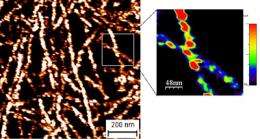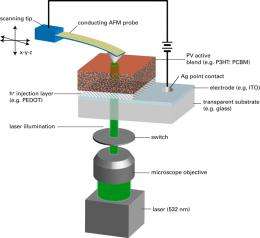Organic solar cell breakthrough

NPL scientists have achieved a significant breakthrough in the metrology of organic photovoltaics – a solar power technology. The research demonstrated a new type of atomic force microscopy that can 'see' down into a working organic photovoltaic cell and relate its three-dimensional nanoscale structure to its performance.
Photovoltaic solar cells have become a much more common sight over recent years, often installed on rooftops where they quietly convert sunlight into clean electricity for homes and businesses.
An organic photovoltaic cell is a type of solar cell that uses organic (carbon-based) electronics and could potentially be a cheaper, more efficient and flexible alternative to today's photovoltaic systems. The technology is on the verge of commercialisation but several obstacles remain, including a necessary increase in performance.
Many recent advances have occurred due to recognition of the pivotal role that morphology plays in efficiency, but it was previously difficult to measure exactly how form and structure affect electrical characteristics and therefore performance.

This research demonstrated that it is possible to obtain structural and electrical information, both on the surface and below the surface to a depth of at least 20 nanometres in operating organic solar cells. The new measurement method is based on a technique called photoconducting atomic force microscopy (pc-AFM) that uses a nanoscale probe to measure topography and photocurrent generation at the same time.
This technique can provide direct correlation between the nanometre scale morphology of a working organic solar cell and its performance characteristics.
This breakthrough will improve understanding of the technology, allowing manufacturers to improve the efficiency of their products by optimising the nanometre scale structure of the organic photovoltaic material.
The work has benefited from strong links with Imperial College London, who contributed with their material and device fabrication expertise.
A manuscript describing the research has been published in Energy and Environmental Science.
Provided by NPL



















